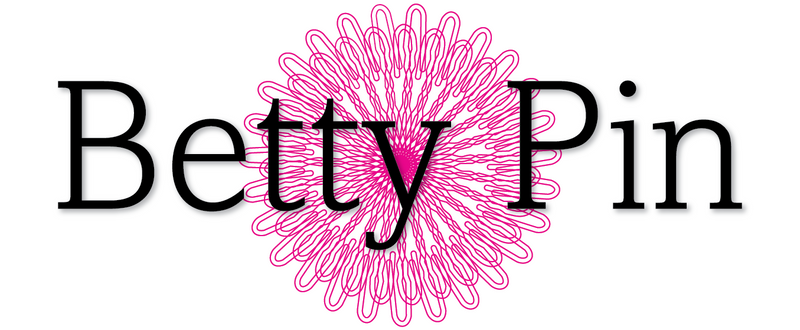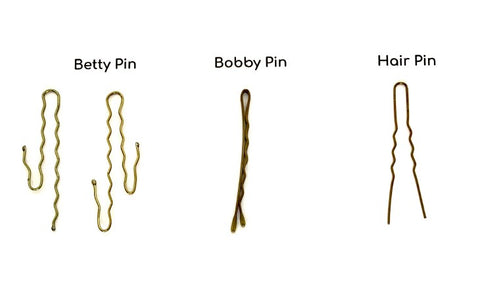Betty Pins vs. Bobby Pins vs. U pins: What's the Difference?
Posted on August 28 2018

"Betty, you complete me." - Bobby Pin
When it comes to up-dos, not all hairpins are created equal. Everyone knows what Bobby Pins are because of their catchy name, but almost nobody outside the industry knows what U-shaped hairpins are used for, and until now Betty Pins never existed. So we are going to take a few minutes to describe what each type of pin is used for and how they can be used to help preserve your hairstyles longer.
Old-school U-shaped hairpins have been around for hundreds of years. Bobby pins (or Bobbi Pins) were named after the Bob-styles that were popular in the sixties and have been around almost as long. Both of these common pins have been essential to hairdressers who are serious about their hairstyles. From a simple topknot to the most elaborate updos imaginable, most professional hairdressers needed to use both Bobby pins and U-shaped hairpins with a ton of hairspray to achieve their best work.
Bobby Pins:
These are the pins most people see in the retail beauty stores and are most commonly bought of when you are thinking of wearing an updo. Bobby pins are closed tight on the arms with a small bent opening at the end. They are flat on one side and have wiggly ridges on the other. Since Bobby pins are designed to compress hair flat to hold firmly in place, Bobby pins should be used at the base of a hairstyle where they won't interfere with the rest of the style. Hairdressers typically only use a couple of bobby pins for the base level holding power where they can be hidden from sight. Some hairdressers and celebrity stylists create unique hairstyles using only Bobby Pins and expose them to make intricate patterns of pins, but generally speaking, most stylists like to keep Bobby pins hidden from view.
Pro Hairstyling Tip: Using Bobby Pins
To use Bobby Pins correctly, insert them in the hair at the base of your style with the smooth side up. It may seem strange but the wavey part of the pin is meant to stay along the scalp to better grab the hair. This will provide better holding power and a more polished overall look.
Traditional Hairpins or "U" pins:
These are the skinny, U-shaped pins that have a little squiggle halfway down each side. Once you see them them recognize them, but they don't have the most memorable name. U-pins are great for setting styles like buns and chignons, but they don't stay in very long without a ton of hair spray or even with a light amount of activity. "Most women aren't sure what hairpins are used for, and virtually all of them don't know how to use hairpins correctly," Betty Pin owner and professional hairstylist, Colleen Lohse says. "Once you know how they are used, though, you'll understand why hairdressers have to have them, and you might try using them yourself.", adds Colleen.
Because U-shaped hairpins don't compress the hair, they offer a wider range of uses for styling that involves looseness, fullness, and delicate shapes. U shaped hairpins make your hairstyles look far more natural than bobby pins can because they allow loose and natural curls, waves, and layers. With the right technique, even non-pros can create the perfect special occasion hair-dos in minutes flat, but just be aware that hairpins do come out fairly easily, especially if you don't saturate your head in hair spray.
Pro Hairstyling Tip: Using Hairpins
- To use U-shaped hairpins correctly, begin by holding the pin between your fingers at the rounded end.
- Start by placing the pin vertically into the hair and insert the ends down into the hair toward the scalp to grab as much hair as needed.
- Next, push the top of the pin down horizontally 90 degrees so that the pin is still in your hair, going into it sideways.
- Push the pin in as far as it will go and still keeping the style you want to achieve.
Betty Pins: The New Pin in Town (and Bobby's New Soul Mate)
It has been well over 50 years since a new hairpin was invented. It is hard to imagine, but we did it, and we did it out of a genuine need to improve one of the oldest staples of the hair industry. The invention of Betty Pins came from Betty Pin's owner/inventor, Colleen Lohse, who was a professional hairdresser in Southern California for over 35 years. During her career, she got tired of bending thousands (probably more like tens-of-thousands) of regular U-pins by hand just to get them to stay in people's hair. She would spend countless hours prepping hairpins and doing amazing hairdos for her clients for weddings, proms, formals, and other special occasions so she needed to be sure her clients' hairstyles wouldn't fall apart at the worst possible time.
So what are Betty Pins and how do they work? Betty Pins are immediately recognizable by the "fishhook" shaped bends and the ends. There are two primary shapes: the Betty Pin "Dancer: with one bend, and the Betty Pin "Rocker" with two, offset fishhook bends. Both designs dramatically increase the u-shaped pin's ability to stay in longer, and the Betty Pin shape you use is ultimately based on how long you need your hair up and how much activity will you be doing while your hair is up.
Betty Pin Dancer pins are designed for every imaginable type of loose bun, updo, half-braid updo, intricate curl cascades, or any complex artwork of hairstyle a stylist can dream up. Dancer pins allow hairdressers to create lovely, loose, and natural updos for all occasions without fear their hairstyles will collapse at the slightest head movement once their clients leave the salon.
Betty Pin Rocker pins are designed for those long heads of hair that are modern marvels of thickness and health springing forth from those blessed with god-like hair genes. You know the ones...


The Rocker's dual offset bends ensure the heaviest, thickest of hairstyles stay put until the wearer decides to undo them. Rocker pins are also great for dancers, athletes, and adventurers who need to have their hair up during their favorite activities and don't want to worry about their hair coming down at a bad time - no matter how hard they move.
Betty Pins are applied the same way traditional U-shaped hairpins are inserted. (see above if you already forgot!)
The proof is in the pudding! If you don't believe how much better Betty Pins stay in your hair than ordinary hairpins, check out this simple shake test video:
Betty Pins stay in so well you will have to know how to take them out. But don't worry it is easy too.
Pro Tip: How to Remove Betty Pins from your hair?
It is very simple, feel for the bends in the hair, straighten the bends out, and slide them out like a regular hairpin! If you want a quick How-to video, watch this:
How-To Video: How to Remove Betty Pins
And remember our motto is to Live it Up!
As always, stay safe and be kind to all.

